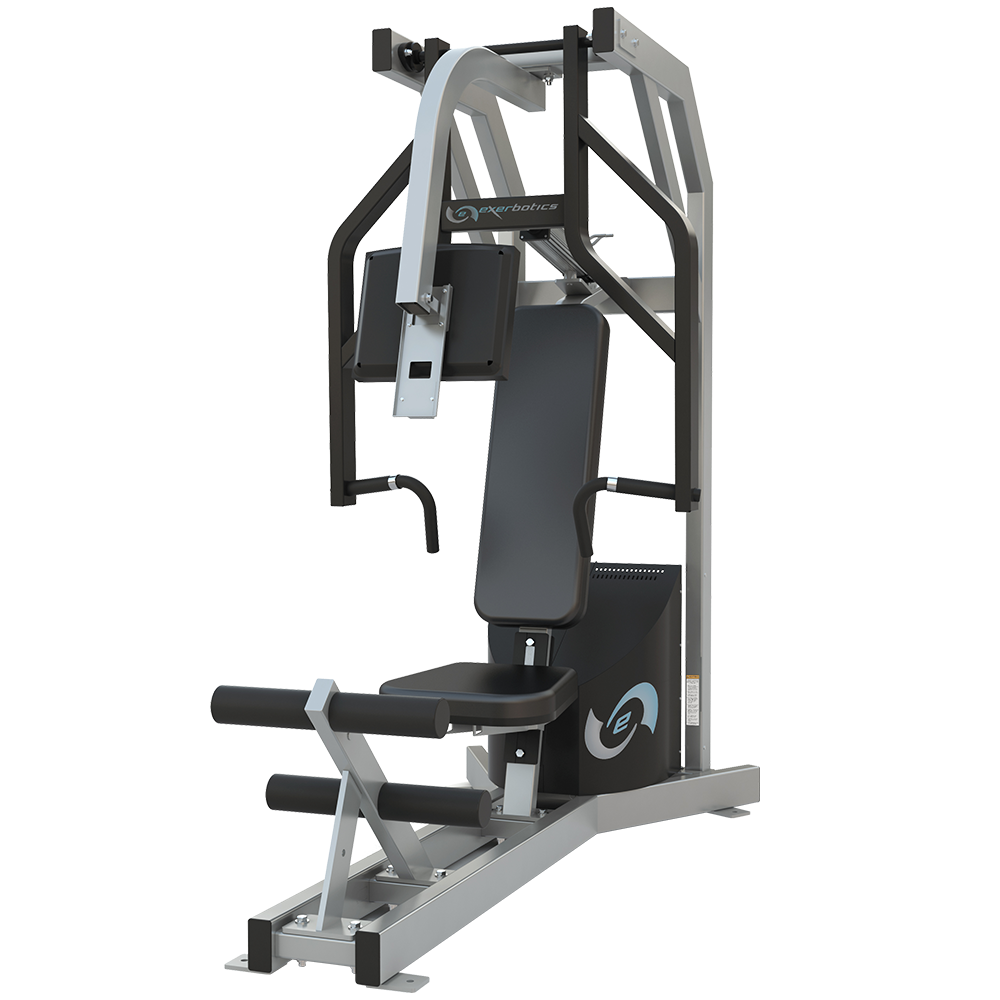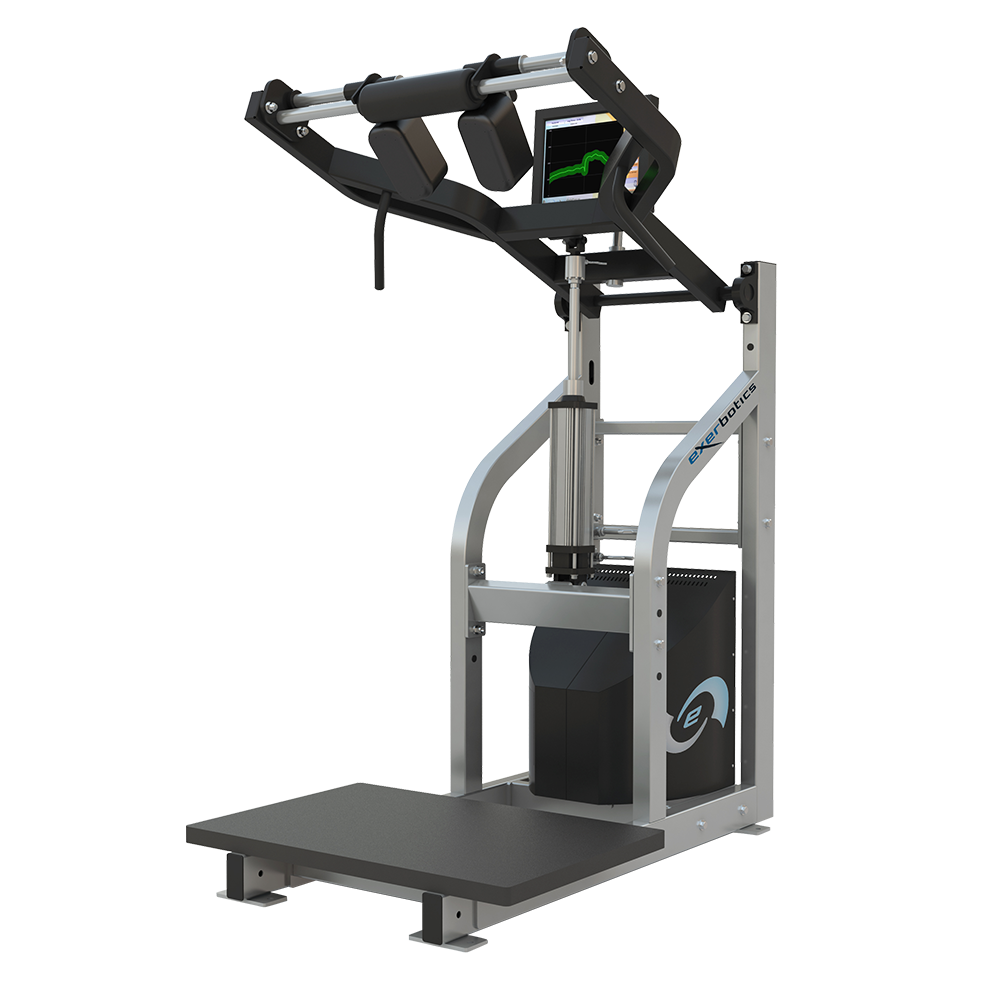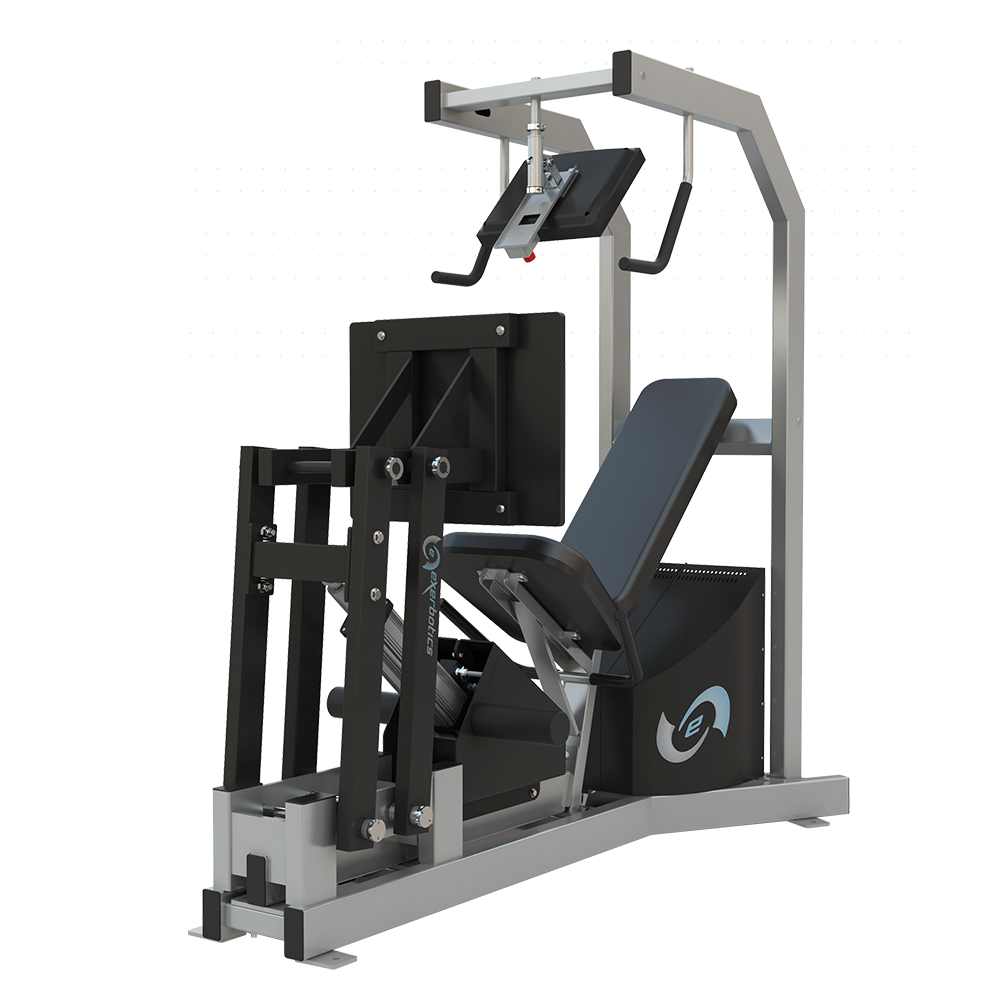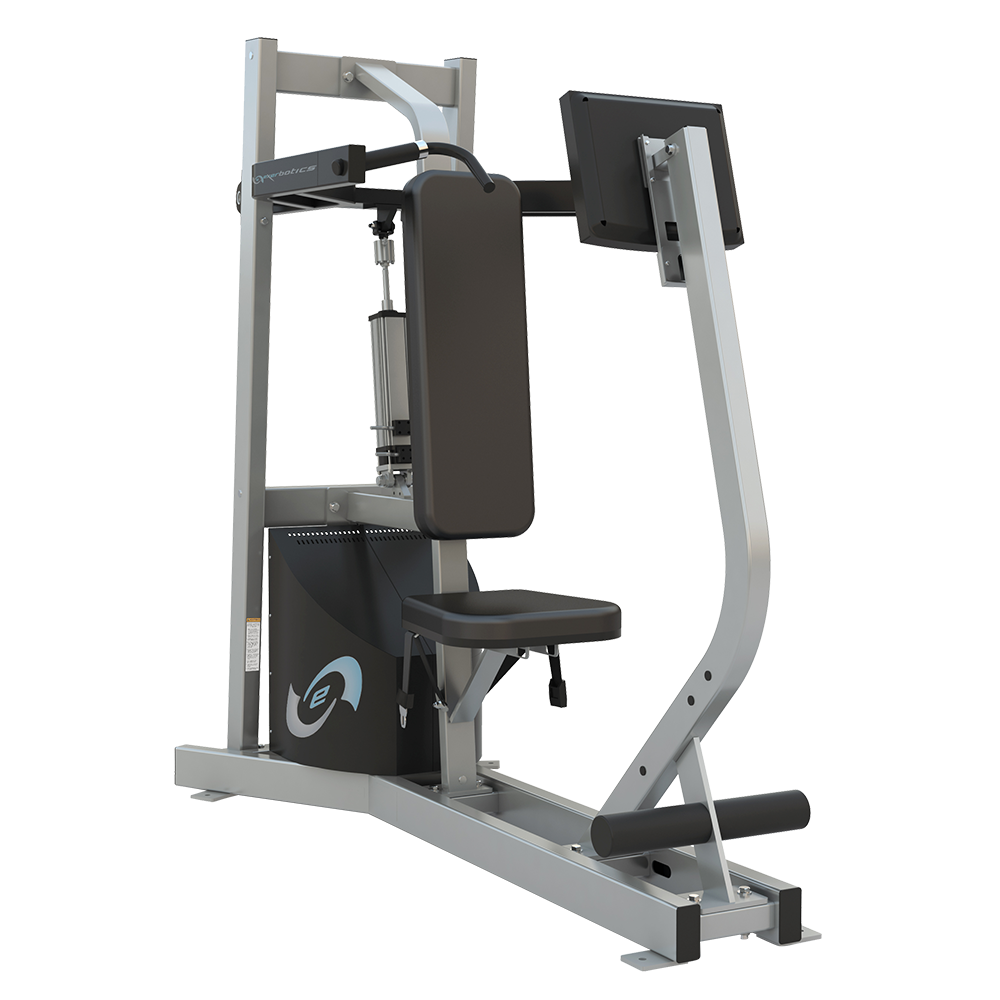NO LIMITS! |
EXERBOTICS MEDICAL, REHABILITATION & SENIOR LIVING APPLICATIONS
Exerbotics creates a safe, controlled environment for higher risk health patients.
The capability to do eccentric only training means individuals with high blood pressure, for example, can get the muscle activation they need without dangerously elevating blood pressure, heart rate and oxygen utilization.
For those with physical limitations, the controlled range of motion makes the product ideal for all types of applications from joint replacement to amputees.
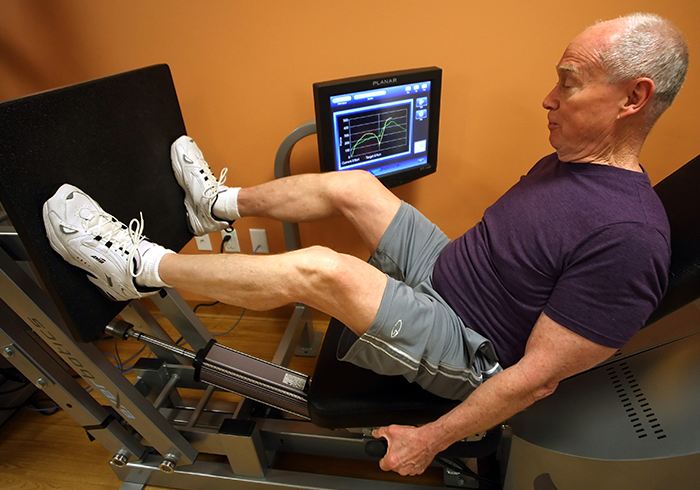
Choose Your Area of Interest: |
![]() According to the International Council of Active Aging:
According to the International Council of Active Aging:
Every day over 10,000 people turn 65 years old.
1 in 5 over 65 years will fall, 80% resulting in a hip fracture.
80% of assisted living residents are there because they are WEAK
…adding up to significant assisted living and healthcare costs.
It is scientifically proven that increasing daily function, reducing the risk of falls and maintaining independence is directly related to maintaining or increasing strength levels.
Specifically, type II muscle fibers must be recruited. Our geriatric exercise equipment allows trainers to target the intensity levels required with short bursts of exercise sessions that will result in significantly improved independence while minimizing metabolic costs.
The Preventable & Curable Epidemic: Frailty
An international consensus report in 2006 characterized frail elders as having impairments in mobility, balance, strength, motor processing, cognition, nutrition, endurance (fatigue) and physical activity.
Although disease is an important cause of frailty, there is sufficient evidence to conclude that frailty is also due to the additive effects of low-grade physiologic loss resulting from a sedentary lifestyle and more rapid loss due to acute insults (illness, injuries, major life events) that result in periods of limited activity and bedrest.
Effects of Frailty on Hospitals and Care Centers
Where can hospitals and senior care centers make a dramatic impact on healthcare costs? More than half of all operations in the United States are performed on persons 65 years and older.
Individuals who register on the Frailty Index have longer stays in the hospital post surgery and are 62% more likely to be re-admitted with post-operative complications or death within 30 days.
The healthcare-related costs of surgery extend beyond the in-patient setting, and include the consumption of resources after hospital discharge. While reported cost of an operation is typically truncated at the end of the hospital stay, the pressures of shorter hospital stays on an aging population require increased post-discharge resources.
Increased cost from time of discharge to six-months following surgery is likely due to increased need for discharge to an institutional care facility and higher thirty day readmission rates in frail individuals.
Post-operative complications are a major factor driving surgical costs and frailty is a preventable driving factor.
The Magic Pill
Properly assessing frailty prior to surgery allows the care providers to assess risk and modify the individual plan to reduce post-surgical complications.
Currently, the most promising area of intervention aims to improve function through exercise regimens with the potential to optimize healthcare outcomes.
Fiatarone showed nursing home residents were able to increase their strength on average 97% after 10 weeks of resistance exercise training. As nursing home residents represent the frailest segment of older adults, this demonstrates the intervention is beneficial for even those most severely affected.
Benefits
These programs are valuable interventions in other frailty domains such as falls, cognitive decline and depression. However, in frail aged patients it is necessary to explore optimal resistance training components and develop specific clinical guides of physical activity for this target population.
Studies have shown the number adverse events are minimal, and the gains of regular exercise clearly outweigh the risks.
High-intensity resistance training (above 60% of the one repetition maximum) has been demonstrated to cause large increases in strength in the elderly. In addition, resistance training result in significant increases in muscle size in elderly men and women. Resistance training has also been shown to significantly increase energy requirements and insulin action of the elderly.
Exerbotics Technology accurately measures capability in order to create an optimal resistance program for each individual resulting in dramatic results in the least amount of time.![]()
A significant proportion of older adults are cognitively impaired, which may impact their ability to properly adhere to a regular exercise regimen. However, if caregivers are involved, this may not be such a barrier. In a randomized clinical trial, subjects with Alzheimer’s dementia participated in a home-based exercise program of aerobic and resistance exercise under the supervision of their caregivers. At three months, the dementia subjects were more active and had better motor functioning compared to the controls. Almost all the trials reviewed in this chapter were clinic or facility based.
Implementing resistance training with cognitively impaired adults can be considered high risk due to the potential injury of the client and those around the client if focus or attention wanders. Using Exerbotics with cognitively impaired adults eliminates this risk as the client is using a machine controlled device that will not drop or operate out of control if the client is distracted or simply stops performing the exercise.
The Exerbotics Advantage
Because of their low functional status and high incidence of chronic disease, there is no segment of the population that can benefit more from exercise than the elderly.
Schneider found that seniors are interested in exercise for its medical and psychological benefits but had concerns about the time required and about their abilities to perform adequate exercise.
The Exerbotics Technology solves many issues with resistance training and muscle endurance for this population.
Safety: The Exerbotics machines never apply force to a person using the products. It requires muscle engagement and measures effort. Therefore you never have to be concerned about loss of control or staff physically managing the client and the resistance methods, regardless of the level of frailty.
Testing: An additional data point to the frailty index, the Exerbotics products provide a simple test to score strength-to-body weight ratio. This score is an easy method to diagnose the severity of frailty and how to prescribe training protocols at the proper intensity to maximize results in the least amount of time.
Strengthening: Exerbotics is a proven device for effectively and dramatically improving strength, muscle endurance and functional mobility. Each client has a customized protocol to take the guesswork and intimidation out of the program. 6 weeks of an Exerbotics routine can transform a client from high risk to ideal reducing hospital costs and general costs of care to facilities.
Reporting: All activity on an Exerbotics machine is documented for each client to track progress, understand overall program effectiveness and demonstrate to the client their improvement. Studies have shown that frail elderly who begin engaging in regular physical activity become more active in their daily life, becoming more independent with a lower risk of hospitalization.
-
Ferrucci L, Guralnik JM, Studenski S, Fried LP, Cutler GB, Jr, Walston JD. Designing randomized, controlled trials aimed at preventing or delaying functional decline and disability in frail, older persons: a consensus report. J Am Geriatr Soc. 2004 Apr;52(4):625–634. [PubMed]
-
Geriatric Review Syllabus – A Core Curriculum in Geriatric Medicine. 6. New York: American Geriatrics Society; 2006
-
Robinson TN, Wallace JI, Wu DS, Wiktor A, Pointer LF, Pfister SM, Sharp TJ, Buckley MJ, Moss M J Am Coll Surg. 2011 Jul; 213(1):37-42; discussion 42-4
-
Fried LP, Tangen CM, Walston J, et al. Frailty in older adults: evidence for a phenotype. J Gerontol A Biol Sci Med Sci. 2001 Mar;56(3):M146–156.[PubMed]
-
Larsson L. Histochemical characteristics of human skeletal muscle during aging. Acta Physiol Scand. 1983 Mar;117(3):469–471. [PubMed]
-
Lindle RS, Metter EJ, Lynch NA, et al. Age and gender comparisons of muscle strength in 654 women and men aged 20–93 yr. J Appl Physiol. 1997 Nov;83(5):1581–1587.[PubMed]
-
Thomas N Robinson, MD, FACS,1,3 Daniel S Wu, MD,1,3 Lauren Pointer, MS,4 Christina L Dunn, BA,1 Joseph C Cleveland, Jr., MD,1,3 and Marc Moss, MD2
-
Liu CK, Fielding RA. Exercise as an intervention for frailty. Clin Geriatr Med. 2011;27:101–10.[PMC free article] [PubMed]
-
Fiatarone MA, O’Neill EF, Ryan ND, et al. Exercise training and nutritional supplementation for physical frailty in very elderly people. N Engl J Med. 1994 Jun 23;330(25):1769–1775. [PubMed]
-
Latham NK, Bennett DA, Stretton CM, Anderson CS. Systematic review of progressive resistance strength training in older adults. J Gerontol A Biol Sci Med Sci. 2004 Jan;59(1):48–61. [PubMed]
-
Chandler JM, Duncan PW, Kochersberger G, Studenski S. Is lower extremity strength gain associated with improvement in physical performance and disability in frail, community-dwelling elders? Arch Phys Med Rehabil. 1998 Jan;79(1):24–30. [PubMed]
-
Galvao DA, Taaffe DR. Resistance exercise dosage in older adults: single-versus multiset effects on physical performance and body composition. J Am Geriatr Soc.2005 Dec;53(12):2090–2097. [PubMed]
-
Peterson MJ, Sloane R, Cohen HJ, Crowley GM, Pieper CF, Morey MC. Effect of telephone exercise counseling on frailty in older veterans: project LIFE. Am J Mens Health.
-
Schneider JK, Eveker A, Bronder DR, Meiner SE, Binder EF. Exercise training program for older adults. Incentives and disincentives for participation. J Gerontol Nurs. 2003 Sep;29(9):21–31. [PubMed]
-
Teri L, Gibbons LE, McCurry SM, et al. Exercise plus behavioral management in patients with Alzheimer disease: a randomized controlled trial. JAMA. 2003 Oct 15;290(15):2015–2022. [PubMed]
-
Liu CK, Fielding RA. Exercise as an Intervention for Frailty. Clinics in Geriatric Medicine. 2011 Feb 27 (1): 101-110.
-
Evans WJ. Exercise training guidelines for the elderly. Med Sci Sports Exerc. 1999 Jan;31(1):12-7.
Strength training can be intimidating even though it holds the keys to independence and quality of life. Well meaning seniors and trainers will invest the time to stay healthy without the proper baseline to know what they should do and how they should do it.
For the trainer it is increased risk to challenge someone who has chronic health problems, is losing stability or has lost independence.
The senior has been told to “be careful, slow down, you can’t do that at your age.” The sad irony is the slowing down and resigning to an age is the cause of their loss of independence, not the age itself.
Exerbotics is a safe environment that removes the guesswork and the intimidation. A personal profile and targets on the screen for exertion levels based on their personal capability make the experience safe, challenging, fun and fast.
Most of this population has one or multiple combinations of joint pain, arthritis, high blood pressure, cardiac disease and many other ailments that are cause for concern when asking someone to exert themselves.
Exerbotics prescriptions can be applied to users to reduce exercise induced high blood pressure and oxygen utilization for greater gains with less risk. Joint pain can be reduced and, through the recruitment of type II muscle fibers, functional strength and mobility can be restored.
At one or two training sessions per week, the commitment is not too overwhelming to maintain.
Exerbotics controls the speed of movement, range of motion and measures user applied effort. The user is exercising to a target based specifically on his or her capability and, if at any moment they feel pain, dizziness or other discomfort, they can simply stop the exercise without any possibility of injury due to losing control of the apparatus they are using.
Because the database stores a personal profile, it also tracks all the activity of each client and provides progress. Completing an initial test will help the staff determine the goals of the individual through their strength to body weight ratio. For example, a Leg Press strength to body weight ratio below 1.0 would be considered “At Risk” and you can begin a progressive plan to increase strength and muscle endurance to 1.5 strength to body weight ratio and above to ensure the functional strength is developed for independence and quality of life.
The Effect of Eccentric and Concentric Leg Strength Training on Postural Balance in the Elderly
Introduction
Falls are a major cause of morbidity and mortality in the elderly. Existing literature shows strong correlation between leg strength, balance and falls.
The purpose of this study is to measure the effect of a structured, eccentric and concentric leg strength training program on postural balance in active, elderly residents in a retirement community.
Our hypothesis was that an eight week, combined eccentric and concentric strength training program would increase lower body strength and improve measures of postural balance in subjects when compared to subjects who did not engage in lower body strength training.
Methods
Twenty-five active adults -12 male and 13 female- aged 72 to 92 years were recruited from a retirement community population. Through randomization, 13 adults were entered into the experimental group and 12 into the control group. The experimental group performed resistance exercise on a computerized leg press, which records both
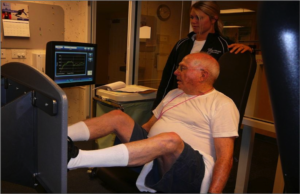
concentric and eccentric strength curves. Workouts consisted of twice weekly strength training on an Exerbotics™machine that maximizes eccentric strengthening.
The control group engaged in their customary self-directed exercise program but without lower body resistance training. Activity logs were maintained by all subjects during the study. Subjects completed a fall risk assessment consisting of an orthostatic hypotension test, timed Get Up and Go Test, and a six-minute walk for distance test. These tests were conducted at baseline and week 8. Measurements of one repetition maximum strength in both the concentric and eccentric phases were recorded atbaseline and week 8.
Results
An improvement in tests of balance and leg strength was observed in the experimental group to a greater degree than in the control group. Both control and experimental groups improved from baseline to 8 weeks for the timed Get Up and Go Test, 7.4 to 7.1 sec. (3.9%) and 7.4 to 6.7 sec (9.7%) and the Six-minute Walk Test 531 to 536 yards (0.1%) and 513 to 537 (4.5 %) respectively. However, the between group comparisons were not significant at the .05 level. This likely reflects the small sample size.
While the eccentric strength improved for both control and experimental groups from baseline to 8 weeks from 250 to 293 lbs (23%) and 239 to 315 lbs (33%) respectively, the between group differences were statistically significant at the .05 level.
Similarly, while concentric strength for both control and experimental groups improved from baseline to 8 weeks from 192 to 220 lbs (18.7%) and 179 to 234 (32%), respectively, the between group differences were statistically significant at the .05 level.
Discussion
Strength training of the lower extremities utilizing both the concentric and eccentric phases of exercise significantly improved strength and balance in our group of elderly patients. The subjects found the computerized equipment of theExerbotics™ machine easy to understand and comfortable to use. The bimonthly 5% increase in weight lifted was easily tolerated by the subjects. The subjects reported minimal soreness during the first two weeks and noticeable strength improvements at week 8.
Maintenance of strength and balance throughout old age is an important goal. Through this study, we found a surprising increase in strength could be attained through utilization of the eccentric, as wellas, the concentric phase, of strength training.
This study shows that utilizing both concentric and eccentric strength training not only maintains, but significantly increases lower body strength and balance in an elderly population. The authors encourage this for all populations at risk for falls.
The results obtained in this pilot study suggest that a repeated study with a larger sample size is warranted.
Adding a senior fitness or rehabilitation program takes different considerations that opening a “workout room”. Comfort, disabilities, motivation and time are all critical elements that are magnified with this population.
If implemented properly however, the benefits to everyone from caregivers to family to the seniors themselves will benefit tremendously.
More maximal strength = more functional strength = fewer falls = fewer hospital visits = fewer fully staffed hours = lower staff and insurance costs.
For seniors the benefits are obvious. A dramatically improved quality of life for many more years with less risk of injury, mental lapses and preventable death.
The keys to a successful implementation of Exerbotics in your Senior application:
- Knowledgeable and friendly staff
- 200 – 400 square feet dedicated to your Exerbotics investment
- Educating your prospective clients on the benefits of this technology
- In service training by an Exerbotics Certified Specialist
- Planned marketing campaign
- Pricing (if applicable)
- Open Houses
- A program for clients to follow for days per week and escalation of activity
If you have questions about the keys to implementation, see Project15.
Strengthening is the key to joint stabilization and recovery. Starting recovery early with Exerbotics allows the therapist to begin safe range of motion work with a client. Exerbotics does not apply external force on the user so progressing comfortably and safely is in the user’s control.
An important concept to understand is that muscles are capable of producing much more force eccentrically compared to concentrically or isometrically. During eccentric contraction force production comes from both the contractile elements in the muscle fibers AND from the viscoelastic components of the connective tissue (primarily tendons)! However during concentric and isometric contractions the force production only comes from the contractile elements.
Another area of extensive benefit from eccentric training is treatment of ACL tears. In fact several well done studies have proven that properly designed eccentric training for ACL rehab is well tolerated and greatly accelerates increases in muscle mass, strength and in hopping ability compared to other forms of rehabilitation.
Exercise to improve muscle mass and strength is a recommended part of cardiac rehabilitation. Concern is often raised regarding the safety of resistance training because of the potential negative effects on cardiopulmonary physiology. Recent studies find that eccentric strength training requires significantly less cardiopulmonary effort for the same resulting strength gain than concentric strength training and is the recommended form of resistance training.
Scientific Studies of Eccentric Resistance
For more than 75 years, scientists have studied the physiology of contracting muscle comparing the metabolic costs of concentric contractions and eccentric contractions.
Hill (1938) observed that muscle contraction during lengthening (eccentric) produced lower muscle heat than during a shortening (concentric) contraction. He showed that eccentric contraction against a same load as compared to a concentric contraction occurred at a lower metabolic cost. Katz (1939) continued Hill’s work and confirmed his findings.
Abbot (1952) studied the physiological cost of negative work using a pair of subjects on two bicycle ergometers coupled in opposition
He compared the cost in oxygen consumption of performing positive work to that of negative work, by the same movements and at the same speed, the only difference being that in the one case the muscles shortened, in the other they were forcibly stretched. He found that positive (concentric) work always cost more than negative (eccentric) with oxygen utilization twice that of concentric versus eccentric work.
Bigland –Ritchie and Woods (1975) recorded steady state measurements of oxygen uptake during concentric and eccentric bicycling and found that not only is less muscle fiber activity required to maintain the same exerted force during negative work exercise, but there is also a substantial reduction in the oxygen uptake when the fibers are stretched.
La Stayo (2003) found that “Force production in skeletal muscle is highest during negative muscle work (an eccentric contraction) when and activated (contracting) muscle is lengthened by an external load” and that “A further benefit of eccentric contractions is that the energy required (i.e., oxygen consumed) to produce negative work is trivial relative to the equivalent magnitude of positive work”.
Meyers (2003) demonstrated that On average, maximum power output achieved with eccentric(ECC) training was fourfold compared with concentric (CON) whereas measures of oxygen uptake and blood lactate were significantly lower (P _ 0.05 each), and ratings of perceived exertion were similar for ECC and CON. She concludes, “For low-risk patients with coronary heart disease without angina, inducible ischemia, or left ventricular dysfunction, ECC can be recommended as a safe new approach to perform high-load muscular exercise training with minimal cardiovascular stress”.
Vallejo (2006) found that in older relatively healthy men and women, heart rate, blood pressure and cardiac index responses were less with eccentric compared with concentric resistance exercise. Also, ventilation responses were less with eccentric compared with concentric resistance exercise.
References
Hill A V. The Heat of Shortening and the Dynamic Constants of Muscle. Proc. R. Soc. Lond. ( 1938) 126;843: 139-195
Katz B. The relationship between force and speed in muscular contraction. J. Physiol. (1939); 96:45-64
Abbott BC, Bigland B, Ritchie JM. The physiological cost of negative work. J. Physiol. (I952) II7, 380-390
Bigland-Ritchie B, Woods JJ. Integrated electromyogram and oxygen uptake during positive and negative work. J. Physio 1976; 260:267-277
LaStayo PC, Ewy GA, Pierotti DD, et al. The positive effects of negative work: increased muscle strength and decreased fall risk in a frail elderly population. J Gerontol A Biol Sci Med Sci. 2003;58:M419-424.
Meyer K, Foster C. Nontraditional exercise training for patients with cardiovascular disease. AJMS 2004:78-81
Bjarnason-Wehrens B, Mayer, Berger W, Meister ER, Baum K, Hambrecht R, Gielen S. Recommendatios for resistance exercise in cardiac rehabilitation. Recommendations of the German Federation for cardiovascular prevention and rehabilitation. European Journal of Cardiovascular Prevention and Rehabilitation 2004. 11:352–361
Vallejo AF, Schroeder ET, Zheng L, Jensky NE, Sattler FR. Cardiopulmonary responses to eccentric and concentric resistance exercise in older adults. Age and Aging 2006;35:291-297
LaStayo PC, Marcus RL, Dibble LE, Smith SB, Beck SL. Eccentric exercise versus usual-care with older cancer survivors: the impact on muscle and mobility-and exploratory pilot study. BMC Geriatrics 2011,11:5
LaStayo P, McDonagh P, Lipovic D, Napoles P, Bartholomew A, Esser K, Lindstedt S. Elderly Patients and high force resistance – a descriptive report: can an anabolic, muscle growth response occur without muscle damage or inflammation? Journal of Geriatric Physical Therapy Vol. 30;3:128-134
Roig M, O’Brien K, Kirk G,Murray R, Mckinnon P, Shadgan B Reid WD. The effects of eccentric versus concentric resistance training on muscle strength and mass in healthy adults: a systematic review with meta-analysis. Br J Sports Med 2009;43:556–568.
Meyer K, Steiner R, LaStayo P, Lippuner K, Allemann Y, Eberli F, Schmid J, Saner H, Hoppeler H. Eccentric Exercise in Coronary Patients: Central Hemodynamic and Metabolic Responses. Med. Sci. Sports Exerc., 2003. Vol.35, No. 7, pp. 1076–1082
Implementing a rehabilitation and strengthening protocol for cardiac rehab on Exerbotics equipment requires less time and fewer repetitions than traditional programs. Most importantly, capability based exercise will ensure your programs are the most effective and you will have the data to prove it.
Below are some basic guidelines for working with a cardiac rehab patient on Exerbotics. Every patient is different and should be monitored closely by medical and rehabilitation personnel.
After the client has been properly programmed in the system with a safe range of motion and baseline tests, begin training with a conservative approach. Ideally an upper body push / pull machine such as a Chest Press / Row and a lower body unit such as a Leg Press would be used for rehab. A Shoulder Press / Pulldown is a great compliment for added benefit.
Some people like the Squat as part of the lower body application as the functional movement is tremendous in building total body function and strength. Typically range of motion and repetitions are limited during early adaptations to the Squat.
For this example, we will assume one upper body push, upper body pull and lower body set will be performed each day.
Week 1 & 2:
- One training session
- 4 repetitions, 10% concentric effort, 50% eccentric effort, 50% range of motion
Week 3:
- Two training sessions
- 4 repetitions, 15% concentric effort, 55% eccentric effort, 60% range of motion
Week 4:
- Two training sessions
- 4 repetitions, 20% concentric effort, 60% eccentric effort, 70% range of motion
Week 5:
- Two training sessions
- 5 repetitions, 20% concentric effort, 65% eccentric effort, 80% range of motion
Week 5:
- Two training sessions
- 6 repetitions, 20% concentric effort, 65% eccentric effort, 90% range of motion
Week 6 & 7:
- Two training sessions
- 6 repetitions, 25% concentric effort, 65% eccentric effort, 100% range of motion
Week 8: Retest
If the client is able to follow the regimen, at 8 weeks the test should demonstrate a 10% – 20% increase in Strength-to-Body-Weight Ratio. Other factors such as weight loss and cardiovascular rehab could increase results.
Monitoring progress and statistical data through the Exerbotics software provides the clinician, patient and medical staff with documented evidence of progression.
For in-depth analysis, see “The True Cost of Frailty” in the “Geriatrics” section. Below is a short excerpt discussing how outcomes can be better, long term care can be reduced and hospital costs can go down by simply having a stronger patient going in to surgery:
Effects of Frailty on Hospitals and Care Centers
Where can hospitals and senior care centers make a dramatic impact on healthcare costs? More than half of all operations in the United States are performed on persons 65 years and older.
Individuals who register on the Frailty Index have longer stays in the hospital post surgery and are 62% more likely to be re-admitted with post-operative complications or death within 30 days.
The healthcare-related costs of surgery extend beyond the in-patient setting, and include the consumption of resources after hospital discharge. While reported cost of an operation is typically truncated at the end of the hospital stay, the pressures of shorter hospital stays on an aging population require increased post-discharge resources.
Increased cost from time of discharge to six-months following surgery is likely due to increased need for discharge to an institutional care facility and higher thirty day readmission rates in frail individuals.
Post-operative complications are a major factor driving surgical costs and frailty is a preventable driving factor.
The Magic Pill
Properly assessing frailty prior to surgery allows the care providers to assess risk and modify the individual plan to reduce post-surgical complications.
Currently, the most promising area of intervention aims to improve function through exercise regimens with the potential to optimize healthcare outcomes.
Fiatarone showed nursing home residents were able to increase their strength on average 97% after 10 weeks of resistance exercise training. As nursing home residents represent the frailest segment of older adults, this demonstrates the intervention is beneficial for even those most severely affected.
The Exerbotics Advantage
The Exerbotics Technology solves many issues with resistance training and muscle endurance for this population.
Safety: The Exerbotics machines never apply force to a person using the products. It requires muscle engagement and measures effort. Therefore you never have to be concerned about loss of control or staff physically managing the client and the resistance methods, regardless of the level of frailty.
Testing: An additional data point to the frailty index, the Exerbotics products provide a simple test to score strength-to-body weight ratio. This score is an easy method to diagnose the severity of frailty and how to prescribe training protocols at the proper intensity to maximize results in the least amount of time.
Strengthening: Exerbotics is a proven device for effectively and dramatically improving strength, muscle endurance and functional mobility. Each client has a customized protocol to take the guesswork and intimidation out of the program. 6 weeks of an Exerbotics routine can transform a client from high risk to ideal reducing hospital costs and general costs of care to facilities.
Reporting: All activity on an Exerbotics machine is documented for each client to track progress, understand overall program effectiveness and demonstrate to the client their improvement. Studies have shown that frail elderly who begin engaging in regular physical activity become more active in their daily life, becoming more independent with a lower risk of hospitalization.
-
Ferrucci L, Guralnik JM, Studenski S, Fried LP, Cutler GB, Jr, Walston JD. Designing randomized, controlled trials aimed at preventing or delaying functional decline and disability in frail, older persons: a consensus report. J Am Geriatr Soc. 2004 Apr;52(4):625–634. [PubMed]
-
Geriatric Review Syllabus – A Core Curriculum in Geriatric Medicine. 6. New York: American Geriatrics Society; 2006
-
Robinson TN, Wallace JI, Wu DS, Wiktor A, Pointer LF, Pfister SM, Sharp TJ, Buckley MJ, Moss M J Am Coll Surg. 2011 Jul; 213(1):37-42; discussion 42-4
-
Fried LP, Tangen CM, Walston J, et al. Frailty in older adults: evidence for a phenotype. J Gerontol A Biol Sci Med Sci. 2001 Mar;56(3):M146–156.[PubMed]
-
Larsson L. Histochemical characteristics of human skeletal muscle during aging. Acta Physiol Scand. 1983 Mar;117(3):469–471. [PubMed]
-
Lindle RS, Metter EJ, Lynch NA, et al. Age and gender comparisons of muscle strength in 654 women and men aged 20–93 yr. J Appl Physiol. 1997 Nov;83(5):1581–1587.[PubMed]
-
Thomas N Robinson, MD, FACS,1,3 Daniel S Wu, MD,1,3 Lauren Pointer, MS,4 Christina L Dunn, BA,1 Joseph C Cleveland, Jr., MD,1,3 and Marc Moss, MD2
-
Liu CK, Fielding RA. Exercise as an intervention for frailty. Clin Geriatr Med. 2011;27:101–10.[PMC free article] [PubMed]
-
Fiatarone MA, O’Neill EF, Ryan ND, et al. Exercise training and nutritional supplementation for physical frailty in very elderly people. N Engl J Med. 1994 Jun 23;330(25):1769–1775. [PubMed]
-
Latham NK, Bennett DA, Stretton CM, Anderson CS. Systematic review of progressive resistance strength training in older adults. J Gerontol A Biol Sci Med Sci. 2004 Jan;59(1):48–61. [PubMed]
-
Chandler JM, Duncan PW, Kochersberger G, Studenski S. Is lower extremity strength gain associated with improvement in physical performance and disability in frail, community-dwelling elders? Arch Phys Med Rehabil. 1998 Jan;79(1):24–30. [PubMed]
-
Galvao DA, Taaffe DR. Resistance exercise dosage in older adults: single-versus multiset effects on physical performance and body composition. J Am Geriatr Soc.2005 Dec;53(12):2090–2097. [PubMed]
-
Peterson MJ, Sloane R, Cohen HJ, Crowley GM, Pieper CF, Morey MC. Effect of telephone exercise counseling on frailty in older veterans: project LIFE. Am J Mens Health.
-
Schneider JK, Eveker A, Bronder DR, Meiner SE, Binder EF. Exercise training program for older adults. Incentives and disincentives for participation. J Gerontol Nurs. 2003 Sep;29(9):21–31. [PubMed]
-
Teri L, Gibbons LE, McCurry SM, et al. Exercise plus behavioral management in patients with Alzheimer disease: a randomized controlled trial. JAMA. 2003 Oct 15;290(15):2015–2022. [PubMed]
-
Liu CK, Fielding RA. Exercise as an Intervention for Frailty. Clinics in Geriatric Medicine. 2011 Feb 27 (1): 101-110.
-
Evans WJ. Exercise training guidelines for the elderly. Med Sci Sports Exerc. 1999 Jan;31(1):12-7.
There are several reasons for O & P practitioners to use Exerbotics proprietary equipment in their practice:
Preparation for amputation surgery: Using Exerbotics in advance of surgery can help strengthen the patient for faster recovery and better prepare them for rehabilitation after the surgery.
Post-Op: Strength training is a proven mechanism for maximizing the effectiveness of rehabilitation post surgery. Strengthening of the residual limb can accelerate the healing process. Exerbotics technology allows practitioners to set goals, track and evaluate the patient’s progress.
Tracking Capabilities: Exerbotics tracking capabilities allow for further evidence in determining the level of activity of the patient for qualifying the level of prosthetic device needed or desired.
- Knowledgeable and friendly staff
- 200 – 400 square feet dedicated in your facility to your Exerbotics program
- Educating your patients on the benefits of this technology
- In service training by an Exerbotics Certified Specialist
- A program for patients to follow for days per week and escalation of activity
Come back soon or email us at sales@exerbotics.com for more info.

